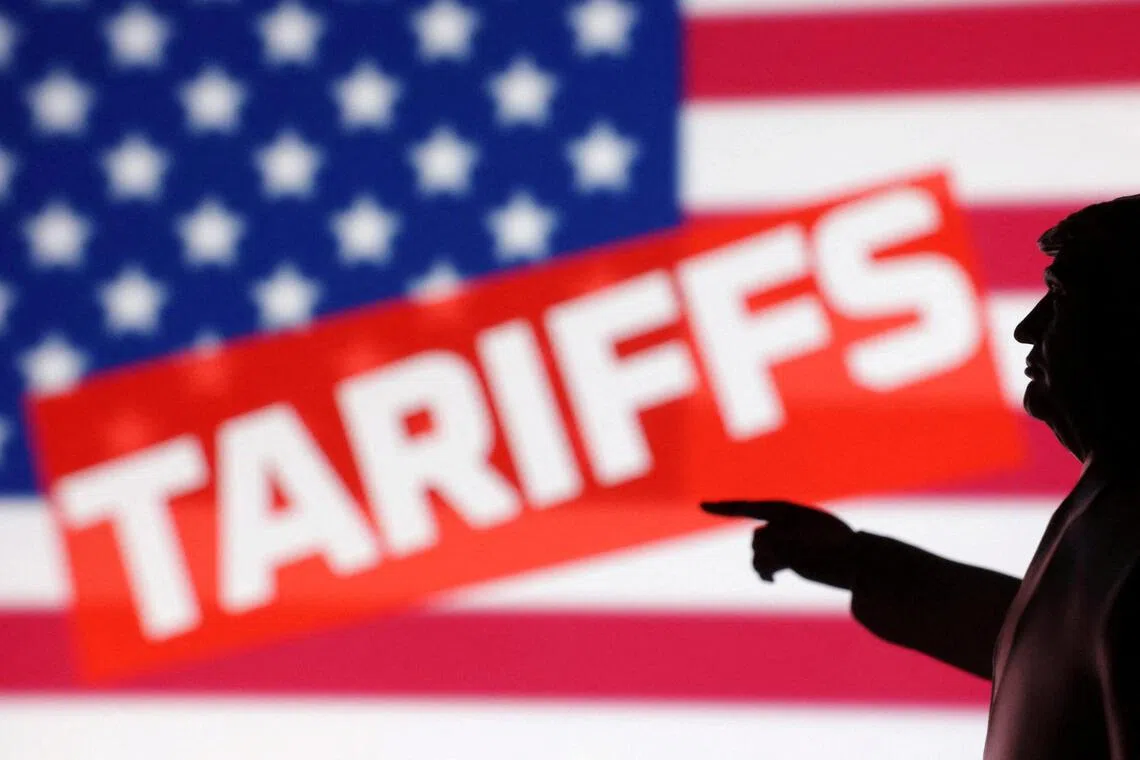Global companies hit by more than $45 billion in US tariffs, but outlook stabilising
Sign up now: Get ST's newsletters delivered to your inbox

Many companies are lowering their initial forecasts as new trade deals reduce exposure to President Donald Trump’s levies.
PHOTO: REUTERS
Follow topic:
Bengaluru - Global companies have flagged more than US$35 billion (S$45 billion) in costs from US tariffs heading into third-quarter earnings, but many are lowering their initial forecasts as new trade deals reduce exposure to President Donald Trump’s levies.
Mr Trump’s trade war has hiked US tariffs to their highest levels since the 1930s, and the president has regularly threatened more duties, but overall, the fog that paralysed many businesses is clearing, allowing executives to forecast costs and make plans - including some price hikes.
Companies expected a combined financial hit of US$21 billion to US$22.9 billion for 2025, with an impact of nearly US$15 billion calculated for 2026, according to a Reuters analysis of hundreds of corporate statements, regulatory filings and earnings calls between July 16 and Sept 30. The total of more than US$35 billion compares with US$34 billion tallied in May, shortly after Mr Trump’s “Liberation Day” tariffs in April rattled global supply chains.
But the trajectory masks a shift: the increase is largely due to Toyota’s US$9.5 billion estimate. Many other companies have lowered their earlier worst-case forecasts after Mr Trump reached lower-rate trade deals with the European Union (EU) and Japan.
The figures combine annual and partial-year estimates from an overlapping group of firms. Both groups include about 60 firms. French spirits makers Remy Cointreau and Pernod Ricard both lowered estimates of tariff pain after the EU deal, while Sony in August cut its forecast. Mr Trump also carved out exceptions, with only about a third of Brazil’s exports facing a 50 per cent tariff, for instance.
“Tariffs are getting clearer and clearer. And we believe that tariffs will be just another variable of our business equation that we need to be ready to manage, and we will,” Stellantis chief executive officer Antonio Filosa told Reuters in a mid-October interview, introducing new details of a US$13 billion, four-year investment in US manufacturing. Stellantis in July warned of a 1.5 billion-euro (S$2.3 billion) hit from US tariffs on 2025.
“I think there is this sense that we reached a kind of landing point with some of the bilateral trade deals,” said International Chamber of Commerce deputy secretary general Andrew Wilson.
“But there will continue to be much greater complexity and this massive uncertainty.” Case in point: Mr Trump earlier in October floated the idea of additional 100 per cent tariffs on China. On Oct 17, he said the proposed tariffs would not be sustainable, and blamed Beijing for the latest tensions in trade talks between the two countries.
Consumer and manufacturing hit hardest
S&P 500 companies are projected to show an earnings growth rate of 9.3 per cent in the July-September period, a decline from 13.8 per cent in the second quarter, according to LSEG data. Europe’s Stoxx 600 is expected to clock 0.5 per cent growth, down from 4 per cent in the previous quarter.
The pain is concentrated on companies that depend on countries that do not have trade deals. Nike, heavily dependent on suppliers in Vietnam and other Asian countries, raised its tariff impact estimate in late September to US$1.5 billion from US$1 billion. In Europe, Tefal kitchen-ware maker SEB recently cut its profit outlook, citing weaker demand as customers adopted a wait-and-see attitude partly due to tariffs, while H&M cautioned that US tariffs on imports would weigh more heavily on margins in the quarter through November.
“We are cautious about the US heading into the fourth quarter, both connected to the impact of tariffs on the gross margin but equally also the consumer sentiment,” H&M CEO Daniel Erver told Reuters. “We can see the price increases.”
Price increases are the most frequent effect of tariffs cited by companies in the Reuters tracker. Carmakers including Ford, Stellantis, Volkswagen and Toyota collectively have reported billions in tariff-related costs. Ford, for instance, is expecting a cumulative US$3 billion impact.
Still, optimism has ticked up among automakers and auto parts suppliers as Mr Trump has moved toward significant tariff relief for US auto production that could effectively eliminate many of the costs that have hit top car companies.
Drug makers also have started rolling out deals on drug pricing and manufacturing that are tied to US tariff exemptions. Pfizer and AstraZeneca have led the way, and others are expected to follow. REUTERS

